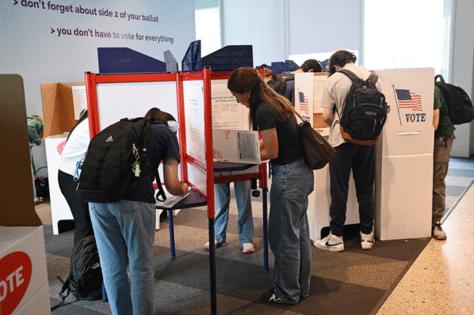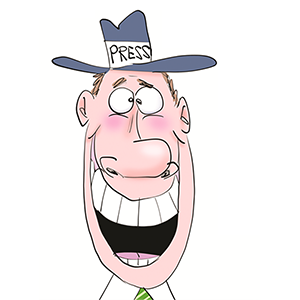How Donald Trump cut into Democrats' hold on young voters
Published in Political News
On the evening of Election Day, Kamala Harris’ campaign was touting high turnout on college campuses in key swing states.
With polls closing, lines at University of North Carolina campuses in Charlotte and Wilmington were several hours long, the vice president’s campaign said. Earlier in the day, the wait to cast ballots was one to two hours on eight different colleges in Wisconsin. And at one point, the line was seven hours long at Lehigh University in Pennsylvania, the campaign said.
But as day turned into night, it became increasingly clear that Harris, 60, was on track to lose the presidential race to 78-year-old Donald Trump. And fewer young voters — despite social-media buzz and endorsements from celebrities like Beyoncé — ended up backing her compared to President Joe Biden’s 2020 run against the Republican.
With Harris garnering 54% of voters under 30, she tied with John Kerry for the lowest level of support for a Democratic presidential nominee since 2004, exit polling conducted by Edison Research shows. Trump increased his share of votes among those between 18 and 29 by 7 percentage points from 2020, according to the data.
The shift is particularly striking since the voting bloc has been reliably Democratic and offers a gloomy outlook for the party’s ability to assemble winning coalitions. Trump made inroads with these voters in part by stressing his economic pitch — a message that appeared to resonate with young adults struggling with student loans and high costs for everything from groceries to housing. Pro-Trump content permeated online, too.
The economy consistently ranked as a top issue among voters in polls leading up to the election, with Americans weighed down by a cumulative 21% rise in inflation since Biden took office. By contrast, the consumer price index climbed just 6% during Trump's first term.
Young voters — who suffered periods of isolation during the Covid-19 pandemic — were heavily influenced by consuming hours of online content, including misinformation about the Democratic Party, said John Della Volpe, a pollster who advised Biden’s 2020 campaign.
Since his 2016 run, “Donald Trump has dominated the airwaves” and has been a looming political figure for the better part of most 20-somethings’ lives, said Marc Lotter, the former president’s 2020 strategic communications director.
“When you see the economy, when you see the lack of wars,” under Trump, he said, “it forms your thought process on many of those things.”
Israel's war in Gaza was unpopular with a sizable segment of the demographic, following Harris to rallies where a small group or a single protester would often interrupt her remarks. A Harvard Youth Poll published in September found 32% of young people supported an arms embargo on Israel. Some protesters threatened to sit out of the election.
Trump grew his support with young men to 56% from 41% in 2020, according to data analyzed by Tufts University’s Center for Information & Research on Civic Learning and Engagement. That showed the success of his approach jockeying for attention in a fragmented media environment and appealing to men directly.
Trump’s appearances on podcasts like The Joe Rogan Experience and Impaulsive with Logan Paul racked up millions of views on YouTube and other platforms, with even wider reach from clips on social media. An endorsement video with World Wrestling Entertainment personalities The Undertaker and Kane, for example, garnered 14 million views on a wrestling fan page on X after a rival fighter endorsed Harris.
“If there’s anything that Donald Trump knows, it’s how to reach an audience,” said Lotter.
Alex Bruesewitz, a 27-year-old adviser to Trump, encouraged the former president to engage with podcasters and influencers, according to people familiar with the matter. Trump's 18-year-old son, Barron, also offered recommendations on interviews, two people said. “My son’s a big fan of yours,” Trump told comedian Theo Von on his podcast, which boasts the fifth-largest podcast audience, according to Edison Research.
Dana White, the Ultimate Fighting Championship chief executive who appeared in Trump’s first TikTok video, played a role in connecting the campaign with creators and celebrities, people familiar with the matter said.
On TikTok, the popular video-sharing app with young Americans, Trump has millions of followers. Jack Advent, a 22-year-old social media strategist who advised Vivek Ramaswamy's primary run, was hired by the campaign in late May to help launch and manage Trump's TikTok account, according to a person familiar with the matter. He also helped coordinate Trump's sit-down with Logan Paul on his podcast.
Kevin Cao, a 20-year-old student at Lehigh University, said he saw pro-Trump content on his TikTok account in the run-up to the election and that he supports Trump’s stance on immigration. “I’m not a big fan of Kamala,” said Cao. “I like his policy on closing the border,” adding that he believes “that’s necessary.”
Trump — who formally announced his candidacy in 2022 — had a long head start on Harris, who entered the race with less than four months until Election Day. Although she and her allies ended up raising more money than him, she struggled to convince voters fed up with Biden that she represented change.
“I love Gen Z,” Harris often said during rallies. But for a substantial portion of Gen Z, generally defined as people between ages 12 and 27, her message didn’t resonate with them — or perhaps even reach them.
Harris’ TikTok account had fewer followers than Trump even when it exploded in popularity in July, as her entrance into the race inspired “brat” references to Charli XCX’s endorsement and viral clips of the vice president’s quirky aphorisms. The Harris campaign didn’t reply to a request for comment.
“When you look at a lot of Democrats’ attempts to reach younger voters over the past many years, it comes off really purposeful, and therefore sometimes feels inauthentic,” said Rachel Janfaza, a political consultant and author of a Gen-Z politics newsletter.
When Harris appeared on the podcast Call Her Daddy, whose audience is largely young women, a featured topic was abortion rights. Although Harris had a huge trust advantage on the issue, some voters, particularly in blue cities and states, appeared to be satisfied with Trump's pledge to leave abortion laws to the states, Janfaza said.
In that podcast interview, Harris was also asked about widespread student loan cancellations, a Biden administration promise felled by the Supreme Court. Though she committed to easing the burden, she avoided making a major vow of her own.
“There was an overwhelming prioritization of the economy and a belief that he was the one prioritizing the economy,” Janfaza said.
_____
(With assistance from Hadriana Lowenkron.)
_____
©2024 Bloomberg L.P. Visit bloomberg.com. Distributed by Tribune Content Agency, LLC.




























































Comments